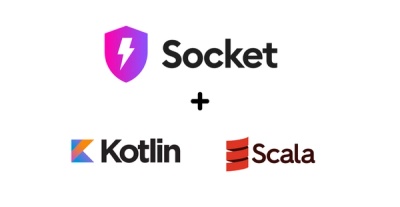
Product
Introducing Scala and Kotlin Support in Socket
Socket now supports Scala and Kotlin, bringing AI-powered threat detection to JVM projects with easy manifest generation and fast, accurate scans.
ethereumjs-vm
Advanced tools
Implements Ethereum's VM in Javascript.
The VM currently supports the following hardfork rules:
ByzantiumConstantinoplePetersburg (default)IstanbulMuirGlacier (only mainnet and ropsten)If you are still looking for a Spurious Dragon compatible version of this library install the latest of the 2.2.x series (see Changelog).
An Ethereum test suite compliant MuirGlacier HF implementation is available
since the v4.1.3 VM release. You can activate a MuirGlacier VM by using the
muirGlacier hardfork option flag.
Note: The original v4.1.2 release contains a critical bug preventing the
MuirGlacier VM to work properly and there is the need to update.
An Ethereum test suite compliant Istanbul HF implementation is available
since the v4.1.1 VM release. You can activate an Istanbul VM by using the
istanbul hardfork option flag.
Supported Istanbul EIPs:
F precompile,
PR #584alt_bn128
precompile gas costs,v4.0.0)npm install ethereumjs-vm
const BN = require('bn.js')
var VM = require('ethereumjs-vm').default
// Create a new VM instance
// For explicity setting the HF use e.g. `new VM({ hardfork: 'petersburg' })`
const vm = new VM()
const STOP = '00'
const ADD = '01'
const PUSH1 = '60'
// Note that numbers added are hex values, so '20' would be '32' as decimal e.g.
const code = [PUSH1, '03', PUSH1, '05', ADD, STOP]
vm.on('step', function(data) {
console.log(`Opcode: ${data.opcode.name}\tStack: ${data.stack}`)
})
vm.runCode({
code: Buffer.from(code.join(''), 'hex'),
gasLimit: new BN(0xffff),
})
.then(results => {
console.log('Returned : ' + results.returnValue.toString('hex'))
console.log('gasUsed : ' + results.gasUsed.toString())
})
.catch(err => console.log('Error : ' + err))
This projects contain the following examples:
All of the examples have their own README.md explaining how to run them.
To build the VM for standalone use in the browser, see: Running the VM in a browser.
For documentation on VM instantiation, exposed API and emitted events see generated API docs.
The API for the StateManager is currently in Beta, separate documentation can be found here, see also release notes from the v2.5.0 VM release for details on the StateManager rewrite.
The VM processes state changes at many levels.
The opFns for CREATE, CALL, and CALLCODE call back up to runCall.
You can subscribe to the following events of the VM:
beforeBlock: Emits a Block right before running it.afterBlock: Emits RunBlockResult right after running a block.beforeTx: Emits a Transaction right before running it.afterTx: Emits a RunTxResult right after running a transaction.beforeMessage: Emits a Message right after running it.afterMessage: Emits an EVMResult right after running a message.step: Emits an InterpreterStep right before running an EVM step.newContract: Emits a NewContractEvent right before creating a contract. This event contains the deployment code, not the deployed code, as the creation message may not return such a code.You can perform asynchronous operations from within an event handler and prevent the VM to keep running until they finish.
In order to do that, your event handler has to accept two arguments. The first one will be the event object, and the second one a function. The VM won't continue until you call this function.
If an exception is passed to that function, or thrown from within the handler or a function called by it, the exception will bubble into the VM and interrupt it, possibly corrupting its state. It's strongly recommended not to do that.
If you want to perform synchronous operations, you don't need to receive a function as the handler's second argument, nor call it.
Note that if your event handler receives multiple arguments, the second one will be the continuation function, and it must be called.
If an exception is thrown from withing the handler or a function called by it, the exception will bubble into the VM and interrupt it, possibly corrupting its state. It's strongly recommended not to throw from withing event handlers.
Developer documentation - currently mainly with information on testing and debugging - can be found here.
See our organizational documentation for an introduction to EthereumJS as well as information on current standards and best practices.
If you want to join for work or do improvements on the libraries have a look at our contribution guidelines.
FAQs
An Ethereum VM implementation
The npm package ethereumjs-vm receives a total of 77,723 weekly downloads. As such, ethereumjs-vm popularity was classified as popular.
We found that ethereumjs-vm demonstrated a not healthy version release cadence and project activity because the last version was released a year ago. It has 6 open source maintainers collaborating on the project.
Did you know?

Socket for GitHub automatically highlights issues in each pull request and monitors the health of all your open source dependencies. Discover the contents of your packages and block harmful activity before you install or update your dependencies.

Product
Socket now supports Scala and Kotlin, bringing AI-powered threat detection to JVM projects with easy manifest generation and fast, accurate scans.

Application Security
/Security News
Socket CEO Feross Aboukhadijeh and a16z partner Joel de la Garza discuss vibe coding, AI-driven software development, and how the rise of LLMs, despite their risks, still points toward a more secure and innovative future.

Research
/Security News
Threat actors hijacked Toptal’s GitHub org, publishing npm packages with malicious payloads that steal tokens and attempt to wipe victim systems.